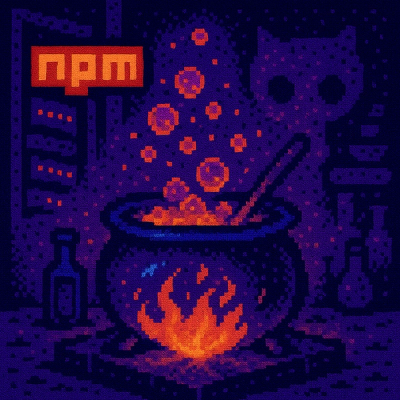
Research
/Security News
9 Malicious NuGet Packages Deliver Time-Delayed Destructive Payloads
Socket researchers discovered nine malicious NuGet packages that use time-delayed payloads to crash applications and corrupt industrial control systems.
websocket-heartbeat-js
Advanced tools
The websocket-heartbeat-js is base on WebSocket of browser javascript, whose main purpose is to ensure web client and server connection, and it has a mechanism of heartbeat detection and automatic reconnection. When client device has network outage or server error which causes websocket to disconnect, the program will automatically reconnect until reconnecting is successful again.
When we use the native websocket, if network disconnects, any event function not be executed. So front-end program doesn't know that websocket was disconnected. But if program is now executing WebSocket.send(), browser must discover that message signal is failed, so the onclose function will execute.
Back-end websocket service is likely to happen error, when websocket disconnected that front-end not notice message received. So need to send ping message by timeout. Server return pong message to client when server received ping message. Because received pong message, client know connection normal. If client not received pong message, it is connection abnormal, client will reconnect.
In summary, for solve above two problems. Client should initiative send ping message for check connect status.
1.close websocket connection
If websocket need to disconnect, client must execute WebsocketHeartbeatJs.close(). If server wants to disconnect, it should send a close message to client. When client received close message that it to execute WebsocketHeartbeatJs.close().
Example:
websocketHeartbeatJs.onmessage = (e) => {
if(e.data == 'close') websocketHeartbeatJs.close();
}
2.ping & pong
Server should to return pong message when the client sends a ping message. Pong message can be of any value. websocket-heartbeat-js will not handle pong message, instead it will only reset heartbeat after receiving any message, as receiving any message means that the connection is normal.
npm install websocket-heartbeat-js
import WebsocketHeartbeatJs from 'websocket-heartbeat-js';
let websocketHeartbeatJs = new WebsocketHeartbeatJs({
url: 'ws://xxxxxxx'
});
websocketHeartbeatJs.onopen = function () {
console.log('connect success');
websocketHeartbeatJs.send('hello server');
}
websocketHeartbeatJs.onmessage = function (e) {
console.log(`onmessage: ${e.data}`);
}
websocketHeartbeatJs.onreconnect = function () {
console.log('reconnecting...');
}
<script src="./node_modules/websocket-heartbeat-js/dist/index.js"></script>
let websocketHeartbeatJs = new window.WebsocketHeartbeatJs({
url: 'ws://xxxxxxx'
});
This websocketHeartbeatJs.ws is native Websocket instance. If you need more native Websocket features, operate the websocketHeartbeatJs.ws.
websocketHeartbeatJs.ws == WebSocket(websocketHeartbeatJs.opts.url);
| Attribute | required | type | default | description |
|---|---|---|---|---|
| url | true | string | none | websocket service address |
| protocols | false | string or string[] | none | new WebSocket(, protocols) |
| pingTimeout | false | number | 15000 | A heartbeat is sent every 15 seconds. If any backend message is received, the timer will reset |
| pongTimeout | false | number | 10000 | After the Ping message is sent, the connection will be disconnected without receiving the backend message within 10 seconds |
| reconnectTimeout | false | number | 2000 | The interval of reconnection |
| pingMsg | false | any | "heartbeat" / ()=>"heartbeat" | Ping message value |
| repeatLimit | false | number | null | The trial times of reconnection。default: unlimited |
const options = {
url: 'ws://xxxx',
pingTimeout: 15000,
pongTimeout: 10000,
reconnectTimeout: 2000,
pingMsg: "heartbeat"
}
let websocketHeartbeatJs = new WebsocketHeartbeatJs(options);
Send the message to the back-end service
websocketHeartbeatJs.send('hello server');
The front end manually disconnects the websocket connection. This method does not trigger reconnection.
websocketHeartbeatJs.onclose = (e) => {
console.log('connect close');
}
websocketHeartbeatJs.onerror = (e) => {
console.log('connect onerror');
}
websocketHeartbeatJs.onopen = (e) => {
console.log('open success');
}
websocketHeartbeatJs.onmessage = (e) => {
console.log('msg:', e.data);
}
websocketHeartbeatJs.onreconnect = (e) => {
console.log('reconnecting...');
}
FAQs
websocket heartbeat
We found that websocket-heartbeat-js demonstrated a not healthy version release cadence and project activity because the last version was released a year ago. It has 1 open source maintainer collaborating on the project.
Did you know?

Socket for GitHub automatically highlights issues in each pull request and monitors the health of all your open source dependencies. Discover the contents of your packages and block harmful activity before you install or update your dependencies.

Research
/Security News
Socket researchers discovered nine malicious NuGet packages that use time-delayed payloads to crash applications and corrupt industrial control systems.

Security News
Socket CTO Ahmad Nassri discusses why supply chain attacks now target developer machines and what AI means for the future of enterprise security.

Security News
Learn the essential steps every developer should take to stay secure on npm and reduce exposure to supply chain attacks.